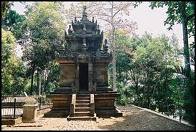Pencak silat term consisting of a compound word of Pencak Silat and although there are different but generally interpreted as the martial art that grows and develops in Indonesia at this time of Disabled Martial arts is also claimed as the typical Malay Indonesia Malaysia and Brunei Darussalam
Pencak term generally used by people on the island of Java, Madura and Bali. Pencak Silat is bersal flow from west Java is Cimande, Cikalong, Sabandar and sera. Of the flow is summarized in a complete system consisting of grounding sociological history, strategy, tactics and techniques. benerapa college Tajimalela including martial arts, young Mande, Manderaga, Pager golden etc. Flow in tatar Sunda silat consists of:
Flow Cimande: Founder / creator of this genre was called Father kahir often also called Kaer grandparent / Grandmother Khoer. Around 1760 he began to introduce his students by that because he was regarded as the founder of the flow on Disabled silat Cimande although in its history has not been clearly terunggkap Kaer grandparent who created these moves. According to historical records in the text of the Song of Sunda mentioned that in those days there were already seven Padjadjaran Kingdom of Disabled Silat.
Genealogy of the characters Cimande include: grandparent Kahir, Embang Rangga, grandparent Ace Naseha, Haji Abdul grandparent Shamad, grandparent Haji Idris, grandparent Hajo Ajid, grandparent pilgrimage Zarqasih, Niftah Haji, Haji, R. A Sutisna
Cikalong flow: A history of the flow Cikalong (Raden Ateng) dalah a son of one of the Regents are very interested in Pencak Silat who also once a student of physical Kahir.Pembinaan Abah and the use of a sense of the expression of many different persamaanya its use only in the martial arts fitness dalah of flavor that is used up dance as a medium of expression while giving birth nyang motion that uses the beauty of the soul is born by the artists. As dance and martial arts as aesthetic needs / the beauty of art terms in tatar Sunda martial arts known as the fruit and Eusi and Flower / ibing on Disabled. Pencak ibing examples derived from the Martial Cimande is slap two salancar (Cimande Dance conservatively) two sorongdayung slap, slap two buangkelid, slap two new homes come on Cimande bdan dances. Cimande usually sung to the rhythm of slap two rack tempo (slow), but there is an homage to rhythm come on stream Paleredan ibingnya Cikalong which generally uses a fast tempo rhythm slap tilu (spry).
Tilu Cikalong and slap slap Tilu jalamuka of the flow of many streams kereografi Cimande, Cikalong and Sabandar. Disabled musicians consists of 2 pieces of big drums and 2 small cages (kulanter) drum fill charge motion and set the tempo while the trumpet as a melody, a small gong as a regulator of rhythm.
This type of rhythm basically there are four, namely:
1. Slap Two
2. Slap Tilu
3. Golempang
4. Padungdung
The name of the song in on Disabled slap Two, Flower Gadung, Ayun udder, Polos, Gedong Kulon, Kawung stumps, bricks collapsed, Song, Sorong Paddle while slap-ucingan Tilu Ucing, Flower Beureum, Bardin, Sintren, Papare, Bendrong Petit, Gendu, Kapok Cotton, Garungan, Joher, Maniang, Salted Peanut-squash Oyong bangkong, Ciwaringin, Mainang.
Pleredan, Ayun udder, Bela Starch, Sasalimpetan, Fruit Kawung Falkirk, Gendu, Gaya, Sari, Flower Beureum, Padungdung, Banon Dari, Song, Koleran, Lengleang, Ceurik Rahmana.
In Bandung Regency recorded almost 38 martial arts groups that are scattered in each district and villages including Panglipur group, the young Rays Heritage, golden sari, Sinar heirlooms, golden bloom, wargi medal, purwa Panghegar, strain sawargi, son kiwari, etc. The golden rope
Indonesia Art
Arts And Culture And Holiday Destination In Indonesia
Thursday, October 6, 2011
Tuesday, September 20, 2011
Cangkuang Temple
Cangkuang Temple is 10 kilometers from Tarogong to the North in the direction to Bandung. To go there, tourists particularly foreigners took delman (a traditional land transportation with horse in the front). Beautiful flowers cover the shallow situ. There is a small island in the middle of the lake, namely Cangkuang temple. It is the only Hindu temple that ever found in West Java is the important discovery in the past. Cangkuang has been built in the period of the first Sundanese Kingdom: Galuh Kingdom. Near the temple, there are heritage graves from the Moslem follower Arif Muhammad, who is one of the Mataram Kingdom soldier from Central Java when attacking the Dutch Colonialist in Batavia (now Jakarta), at the 17th Century. The ambush failed, he refused to return and stayed in Cangkuang for teaching and disseminating Islam to the surrounding community, precisely in Kampung Pulo, where his hereditary stays until now. In Kampung Pulo, can be found the traditional village, which contains six houses in a row and face-to-face, three on the left and three on the right, plus one mosque, which stays only six families. In the edge of the lake, to reach Cangkuang temple, people must use traditional transportation made from bamboo, but safe and comfortable that is called rakit
Subscribe to:
Comments (Atom)

